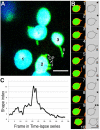Fluorescent Protein Aided Insights on Plastids and their Extensions: A Critical Appraisal
- PMID: 26834765
- PMCID: PMC4719081
- DOI: 10.3389/fpls.2015.01253
Fluorescent Protein Aided Insights on Plastids and their Extensions: A Critical Appraisal
Abstract
Multi-colored fluorescent proteins targeted to plastids have provided new insights on the dynamic behavior of these organelles and their interactions with other cytoplasmic components and compartments. Sub-plastidic components such as thylakoids, stroma, the inner and outer membranes of the plastid envelope, nucleoids, plastoglobuli, and starch grains have been efficiently highlighted in living plant cells. In addition, stroma filled membrane extensions called stromules have drawn attention to the dynamic nature of the plastid and its interactions with the rest of the cell. Use of dual and triple fluorescent protein combinations has begun to reveal plastid interactions with mitochondria, the nucleus, the endoplasmic reticulum and F-actin and suggests integral roles of plastids in retrograde signaling, cell to cell communication as well as plant-pathogen interactions. While the rapid advances and insights achieved through fluorescent protein based research on plastids are commendable it is necessary to endorse meaningful observations but subject others to closer scrutiny. Here, in order to develop a better and more comprehensive understanding of plastids and their extensions we provide a critical appraisal of recent information that has been acquired using targeted fluorescent protein probes.
Keywords: fluorescent proteins; photoconvertible fluorescent protein; plastids; retrograde signaling; stroma; stromules.
Figures





Similar articles
-
New insights on stromules: stroma filled tubules extended by independent plastids.Plant Signal Behav. 2012 Sep 1;7(9):1132-7. doi: 10.4161/psb.21342. Epub 2012 Aug 17. Plant Signal Behav. 2012. PMID: 22899053 Free PMC article.
-
Stromules and the dynamic nature of plastid morphology.J Microsc. 2004 May;214(Pt 2):124-37. doi: 10.1111/j.0022-2720.2004.01317.x. J Microsc. 2004. PMID: 15102061 Review.
-
Dynamic morphology of plastids and stromules in angiosperm plants.Plant Cell Environ. 2008 May;31(5):646-57. doi: 10.1111/j.1365-3040.2007.01768.x. Epub 2007 Dec 10. Plant Cell Environ. 2008. PMID: 18088332 Review.
-
In vivo analysis of interactions between GFP-labeled microfilaments and plastid stromules.BMC Plant Biol. 2004 Feb 10;4:2. doi: 10.1186/1471-2229-4-2. BMC Plant Biol. 2004. PMID: 15018639 Free PMC article.
-
Microfilaments and microtubules control the morphology and movement of non-green plastids and stromules in Nicotiana tabacum.Plant J. 2003 Jul;35(1):16-26. doi: 10.1046/j.1365-313x.2003.01777.x. Plant J. 2003. PMID: 12834398
Cited by
-
Induced cardiomyocyte maturation: Cardiac transcription factors are necessary but not sufficient.PLoS One. 2019 Oct 17;14(10):e0223842. doi: 10.1371/journal.pone.0223842. eCollection 2019. PLoS One. 2019. PMID: 31622977 Free PMC article.
-
Arabidopsis PARC6 Is Critical for Plastid Morphogenesis in Pavement, Trichome, and Guard Cells in Leaf Epidermis.Front Plant Sci. 2020 Jan 15;10:1665. doi: 10.3389/fpls.2019.01665. eCollection 2019. Front Plant Sci. 2020. PMID: 32010156 Free PMC article.
-
Two Independent Plastid accD Transfers to the Nuclear Genome of Gnetum and Other Insights on Acetyl-CoA Carboxylase Evolution in Gymnosperms.Genome Biol Evol. 2019 Jun 1;11(6):1691-1705. doi: 10.1093/gbe/evz059. Genome Biol Evol. 2019. PMID: 30924880 Free PMC article.
-
Structural associations between organelle membranes in nectary parenchyma cells.Planta. 2018 May;247(5):1067-1076. doi: 10.1007/s00425-018-2844-7. Epub 2018 Jan 17. Planta. 2018. PMID: 29344723
-
Autophagy Inhibitors Do Not Restore Peroxisomal Functions in Cells With the Most Common Peroxisome Biogenesis Defect.Front Cell Dev Biol. 2021 Apr 1;9:661298. doi: 10.3389/fcell.2021.661298. eCollection 2021. Front Cell Dev Biol. 2021. PMID: 33869228 Free PMC article.
References
Publication types
LinkOut - more resources
Full Text Sources
Other Literature Sources

